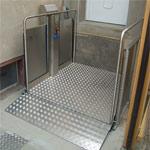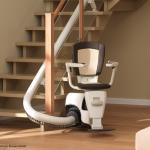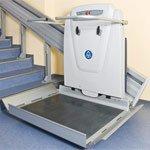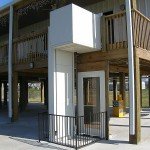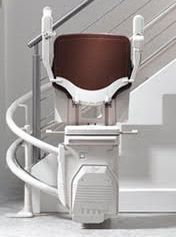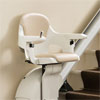For anyone who has mobility limitations and lives in a home with multiple levels, getting around can be a challenge. For people with injuries, illnesses or other disabilities that make climbing stairs difficult, installing a stairlift or homelift can help them get from one floor of a home to another more easily. Below, we outline the differences between the two types of lifts to help you better decide whether a stair lift or home lift is better suited for your home.
Of the two types of lifts, a stair lift is more obvious because it cannot be hidden, although it can be folded when not in use. A stair lift can have a seat or platform, and some are also equipped with safety bars and belts. The seat and rail to which the stairlift is attached can have different finishes and colors. Most stairlifts are utilitarian and functional.
Home lifts that use a shaft are covered by panels or a shaft frame. The interior also offers a variety of style options. Home elevators that do not use a shaft, such as pneumatic elevators, can be installed freestanding in a room. They can be made of a plastic tube or a framework of clear glass. They are usually not decorative or available with many options, but they are small and can be installed in many places in a home where they will not be noticeable.
Homelift vs. stairlift: size and space
Stairlifts come in different widths for different sets of stairs. Home lifts are not always narrow enough to be retrofitted in a stairwell. In some cases, it may be necessary to remove a railing to make the elevator fit, which can increase the cost of the project. Some elevator companies do make elevators for narrow stairwells, but the selection is limited.
Stairlifts are folded when not in use, so that the stairs are still accessible. The smallest stair lift has a depth of about 40 cm. Platform lifts that can accommodate a wheelchair may take up considerably more space, usually up to 90 cm.
Advantages | Disadvantages |
|---|---|
| Flexible install locations | More difficult to install |
| Can be decorative | Can take up a lot of space |
| Can add value to all dwellers | Can be noisy |
| Makes higher floors of the house accessible | Requires annual maintenance |
| Increases home resale value | Installation may take several weeks |
| Can be installed outdoors | Frequently requires home modifications |
| A care cost subsidy of up to € 4,000 is possible | Costs start at €20,000 |
Home lifts also come in a variety of sizes and widths. The largest elevator, which you can install according to the regulations, has a size of 1.7 square meters. The smallest is about 1.1 square meters. Home elevators that use a shaft require additional space behind, below or beside the elevator to accommodate a motor. For example, a rope-driven elevator requires a separate room for the motor, which is located behind the shaft. A pneumatic elevator requires only the space needed for the car itself and therefore takes up less space overall.
Homelift or stairlift? Installation
Stairlifts are faster, easier and less expensive to install than home lifts. They can usually be installed within three to four hours. It is usually recommended that the manufacturer does the installation, especially if you have purchased a curved staircase or a custom stairlift.
Homelifts that require a shaft take considerably longer to install, possibly up to three weeks. A home lift that does not require a shaft can be installed in a matter of days. Pneumatic elevators, which also do not use a shaft, are the easiest and least expensive to install because they require minimal construction. Hydraulic and cable-driven home lifts require a manhole and extensive machinery, which take longer to install and are therefore a major intrusion into your home. There are some newer hydraulic home lifts that do not require a traditional shaft. However, there is a lot more machinery to install than with a pneumatic elevator. It will take a few days to weeks to install.
Homelift vs. stairlift: costs
In most cases, the cost of installing both stairlifts and elevators is already included in the total cost you pay to the manufacturer. The average cost of a stairlift is between €3,800 and €5,000, with the stairlift itself costing between €1,000 and €3,000 and labor costs averaging around €2,000.
Advantages | Disadvantages |
|---|---|
| Installed in hours | Difficult to hide |
| DIY installation available | Fewer design options |
| Available in different widths | Does NOT increase the resale value of a home |
| Quiet | Requires annual maintenance |
| Does not take up much space | Difficult to install on very narrow stairs |
| Makes higher floors of the house accessible | May require the removal of the stair railing |
| Care cost subsidy of up to € 4,000 is possible | The costs start from 4.000 € |
Home lifts have a wider range due to the many designs. A pneumatic elevator costs about €25,000 to go up one floor, with the elevator itself costing between €10,000 and €15,000. A hydraulic elevator costs about €20,000 to go up one floor, with the elevator itself costing about €10,000. The cost can be significantly higher when going up more than one floor or when using a customized cabin.
Homelift or stairlift? Noise
Both stair lifts and home lifts make noise. Rope driven elevators are the noisiest due to the type of machinery used. Pneumatic elevators are the quietest, and most stair elevators are designed to make minimal noise.
If you have an elevator shaft, you can install an acoustic enclosure to muffle the noise. However, it is recommended to install a home lift away from bedrooms or other sound-sensitive areas if more than one person lives in the home.
Homelift vs. stairlift: maintenance
Both home lifts and stair lifts should be inspected annually.



